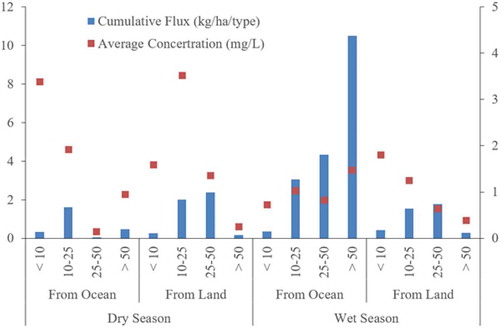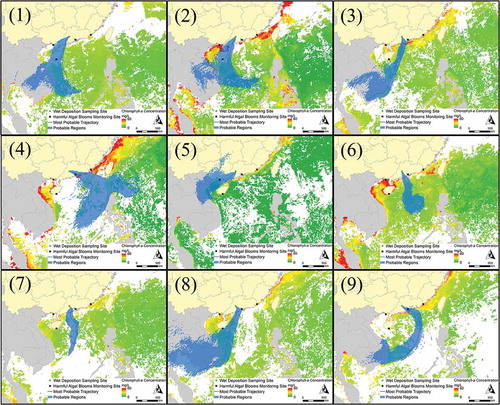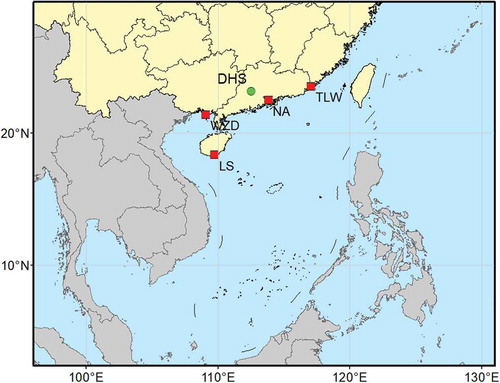ABSTRACT
The aim of this study is to elaborate a possible missing source of high-throughput organic nitrogen in rainfall. The authors classified the observed flux data of dissolved organic nitrogen in terms of the attributes of the wet deposition event itself, such as the season, precipitation, air mass backward trajectory, and effect of typhoons. The monitoring results of the ocean eutrophication and the chlorophyll-a map of the surface water were compared with the trajectory of the high-flux deposition events. The results show that approximately one third of the total wet deposition organic nitrogen derived from a confluence of three factors: rain in the wet season, air masses from the ocean, and rainfall over 50 mm. It could be seen that the co-occurrence of intense events such as a typhoon and eutrophic surface sea waters might be an important source of dissolved organic nitrogen in wet deposition.
Graphical abstract

Graphical Abstract
摘要
研究目的:大气有机氮沉降的通量始终与排放的量不吻合,因此其缺失来源值得我们探讨。创新要点:研究发现同时发生台风与海洋富营养化情况下带来的鼎湖山站有机氮湿沉降占到了总有机氮湿沉降的1/3。研究方法:站点湿沉降采样+化学组分分析+后向轨迹模式。重要结论:在海洋富营养化的情况下,台风可能会将海洋表面的含氮组分带入大陆,成为大气有机氮沉降通量的重要组成。
关键词:
1. Introduction
Atmospheric nitrogen deposition has a significant impact on both terrestrial and aquatic ecosystems, and alterations in its level will significantly affect the productivity and stability of an ecosystem (Pacheco, Donoso, and Sanhueza Citation2004; Galloway et al. Citation2008). In recent years, with the reduction of anthropogenic inorganic nitrogen emissions, interest in organic nitrogen (ON) has increased because it represents a large fraction of total nitrogen (TN) (Neff et al. Citation2002; Liu et al. Citation2017). A recent compilation of precipitation data yielded a median ON/TN = 29% and found that ON comprised up to a quarter of TN deposited in rainwater in Europe and Asia, 35%–40% of TN across the Americas, and approximately 40% of TN in open ocean regions (Cornell Citation2011). The concentration of ON in wet deposition been found to reach 1.55 mg L−1 (Zhang et al. Citation2008).
Given this large amount of ON deposition, researchers are interested to find its sources. The current consensus is that the primary sources of ON in the atmosphere include anthropogenic and natural emissions, such as combustion, vehicle exhaust, biomass burning, agriculture, marine biota, and secondary processes (Cape et al. Citation2011; Pan et al. Citation2017). For example, it is usually considered that the main source of ON for a forest region includes forest-dwelling organisms and agriculture and other human activities nearby (Zhu et al. Citation2015). As the Pearl River Delta (PRD) region is among the areas with the highest emission density in China (Streets et al. Citation2003; Zheng et al. Citation2009), our previous study speculated that the deposition–emission relationship in the PRD would behave more like a source region in which the deposition is dominantly influenced by the local emission (Wang et al. Citation2013). Recently, water-soluble ON in seawater has been thought to be a source of atmospheric dissolved organic nitrogen (DON) (Violaki et al. Citation2015; Luo et al. Citation2016, Citation2018). Besides, some studies of the ocean suggest that the growing urban, industrial, and agricultural atmospheric deposition of ON inputs to coastal and offshore waters may be linked to a purported expansion of coastal eutrophication and harmful algal blooms (Howarth Citation2008). A small number of studies have found biogenic amines in the ocean derived from secondary organic aerosols (Facchini et al. Citation2008; Müller et al. Citation2009). However, few have considered the possibility that algal blooms and eutrophic waters may be a source of ON for land remote from the sea (Altieri et al. Citation2016).
In this study, we tracked the reverse trajectory of each air mass responsible for high ON flux precipitation events and superimposed and compared this information with a map of chlorophyll-a concentration in the ocean (obtained from MODIS data) during the same period. The results indicate that one combination of events may bring ON to the Dinghushan region, 120 km from the coast: microalgal blooms from eutrophication or red-tide outbreaks generate ON, and severe weather (such as a typhoon) transports the ON components inland.
2. Method
2.1 Site description
The wet deposition sampling site was in the Dinghushan Nature Reserve in central Guangdong Province, South China (23.16°N, 112.55°E; ). This reserve is 20 km east of the relatively small city of Zhaoqing (330 000 inhabitants), about 90 km west of metropolitan Guangzhou (10 million inhabitants), and 180 km northwest of Hong Kong (7 million inhabitants). The climate is humid subtropical monsoon: April to September is the rainy season, and October to March is the dry season; 75% of the annual precipitation falls from March to August, and only 6% falls from December to February. The average annual rainfall is 1956 mm, the average annual relative humidity is 82%, and the average annual temperature is 20.9°C.
2.2 Sampling and chemical analysis
The precipitation was collected on a daily basis from 2010 to 2011. In some months, no precipitation was sampled because of the small volume and the persistent drought, which might result in an underestimation of the annual precipitation nitrogen input (Ye et al. Citation2018). Precipitation was collected in a beaker (22 cm in diameter, 13 cm deep) with a black polytetrafluoroethylene surface membrane. The collector was washed with distilled water immediately after each collection. Samples were filtered within 24 h of collection through 0.45 µm filters in the laboratory and stored in plastic bottles at 4°C until chemical analysis (Huang et al. Citation2018).
In this study, the DON concentration was defined as the difference between the total dissolved nitrogen and the dissolved inorganic nitrogen ([DON] = [TDN] – [DIN]). We used an ion chromatograph (DX-100 Ion Chromatography System, Dionex Corporation) to determine the concentration of inorganic nitrogen species (NH4-N and NO3-N), and TDN was analyzed after the oxidation of all the N compounds to NO3− via potassium persulfate. It should be noted that NO3-N equals the sum of NO2-N and NO3-N, because of the interconversion of these ions during the chemical analysis (Wang et al. Citation2013). Since the calculation of DON is subject to relatively large and variable uncertainties by error propagation from NH4-N and NO3-N, the data points with high relative uncertainties (>100%) were excluded while the negative values were taken as zero (Luo et al. Citation2018).
2.3 Precipitation-type identification and assessment of marine eutrophication
We classified the observed wet deposition in terms of the different attributes of the source precipitation and the atmospheric conditions at the time of collection. These classification criteria include seasons, rainfall amounts, clouds’ sources, the sources of under-cloud air mass, and the effects of typhoons. To analyze the effect of clouds and airmass transport, 72 h backward trajectories were computed with NOAA’s Hybrid Single-Particle Lagrangian Integrated Trajectory (HYSPLIT) model (http://ready.arl.noaa.gov/HYSPLITtraj.php) at altitudes of 500 and 3000 m above ground level, respectively. Backward trajectories were generated at eight starting times for each day during the study period (every 3 h) using the three-hourly 1° × 1° meteorological data from NCEP’s Global Data Assimilation System. The clouds’ sources were based on the location of the 3000-m backward trajectories’ starting points. The sources of under-cloud air mass were identified according to the ratio of their residence time between marine and terrestrial locations, which was calculated in ArcGIS based on 500 m backward trajectories. The existence of an effect from a typhoon was defined as requiring less than 600 km between the computed backward path of the clouds and the observed path of the eye of the typhoon.
Two data sources were used to determine whether the sea areas over which the computed cloud trajectories were located were eutrophic or experiencing harmful algal blooms. One was data from the Aquaculture Environmental Quality Bulletin of Red-Tide Monitoring Area released by the National Marine Environmental Monitoring Center of China(https://www.nmemc.org.cn/), which uses the red tide risk-index and nutritional status index to characterize the abundance of phytoplankton species in seawater and the eutrophication level of seawater in the ocean surface. The other was the MODIS data of chlorophyll-a, computed by the OceanColor Biology Processing Group, NASA (http://oceancolor.gsfc.nasa.gov/).
3. Results and discussion
The observations in this study indicate that the average flux of DON in the wet deposition was about 14.79 kg ha−1 yr−1 in the Dinghushan region from 2010 to 2011. Due to variation in precipitation levels, the corresponding flux of DON can vary considerably: in 2010 the rainfall was 1536 mm, and the flux was 20.67 kg ha−1 yr−1, but in 2011 the rainfall decreased to 1053 mm, and the flux to 8.90 kg ha−1 yr−1.
However, a further classification of these rain events was performed according to their seasons, the sources of air mass and the rainfall amounts, affording a finely characterized set of data. The respective cumulative flux results in show that one specific type of rain event was responsible for one third of the total wet deposition of ON, even though the average concentration of ON in this type of rain event was not very high. This type of rain event involved rain in the wet season, the amount of rain being over 50 mm, and an ocean-derived air mass. The occasions and other details of the nine rain events with these attributes are listed in . More than half of these were caused by a typhoon, and the others were caused by tropical depressions, stationary fronts, or strong convective conditions.
Table 1. Attributes of each event in the conditions of wet season rain, high rainfall, and ocean-derived air mass.
Figure 2. Cumulative flux and average concentration of DON in each type of rain event classified by season, source of air mass, and rainfall amount.

We superimposed the backward trajectory of each air mass on these events with the same period map of chlorophyll-a extracted from MODIS data. shows the airmass trajectories of these nine over 50 mm rain events and the ocean surface chlorophyll-a levels. 2), 3(4), and 3(6) show co-occurrence of typhoon weather events and high concentrations of chlorophyll-a, which possibly suggests that the eutrophic surface sea waters might be an important source of ON to the Dinghushan area. A strong weather process would be a necessary condition with air masses passing over eutrophic or harmful algal-bloom-rich seawater.
Figure 3. Airmass pathways and marine biomasses of the nine over 50 mm rain events (the numbers correspond to those in ).

Not all these heavy rain types resulted in high ON deposition. Three possible conditions would not have led to the ON fluxes that were high under the heavy rain events. Firstly, the air mass trajectory should pass over the eutrophication region. For example, rain was brought by Typhoon Saraka in event No. 7 and strong convection in event No. 8, but no eutrophication was observed in the South China Sea at these times, and the flux of DON remained at a lower level. Secondly, the air mass should not move too fast. Although the trajectories of events No. 3 and 9 pass across the high chlorophyll-a concentration areas, the residence times were short, which made the air mass unable to take large quantities of eutrophic surface sea waters. And for event No. 6, the air masses stayed for enough time in the eutrophic region, and the flux of DON became the third highest of all these nine heavy rain events. Thirdly, as events No. 1 and 5 showed, the DON remained low when the trajectories travelled through land areas before reaching the final sampling site.
4. Conclusion
Our study shows that sources of ON in wet deposition inland may derive from the ocean some distance away. Specifically, the co-occurrence of a high-intensity weather system such as a typhoon with eutrophication or harmful algal blooms in the ocean can result in the transport and deposition of organic molecules, including ON, a significant distance inland, remote from the coast. Such a mechanism may be a crucial source of ON for ecosystems lacking in nitrogen, and thus it can also be viewed as an important source of both water and nitrogen. Further quantitative and targeted research is needed to confirm the validity of these possibilities.
Disclosure statement
No potential conflict of interest was reported by the authors.
Additional information
Funding
References
- Altieri, K. E., S. E. Fawcett, A. J. Peters, D. M. Sigman, and M. G. Hastings. 2016. “Marine Biogenic Source of Atmospheric Organic Nitrogen in the Subtropical North Atlantic.” Proceedings of the National Academy of Sciences 113 (4): 925–930. doi:10.1073/pnas.1516847113.
- Cape, J. N., S. E. Cornell, T. D. Jickells, and E. Nemitz. 2011. “Organic Nitrogen in the Atmosphere—Where Does It Come From? A Review of Sources and Methods.” Atmospheric Research 102 (1–2): 30–48. doi:10.1016/j.atmosres.2011.07.009.
- Cornell, S. E. 2011. “Atmospheric Nitrogen Deposition: Revisiting the Question of the Importance of the Organic Component.” Environmental Pollution 159: 2214–2222. doi:10.1016/j.envpol.2010.11.014.
- Facchini, M. C., S. Decesari, M. Rinaldi, C. Carbone, E. Finessi, M. Mircea, F. Sandro, et al. 2008. “Important Source of Marine Secondary Organic Aerosol from Biogenic Amines.” Environmental Science & Technology 42 (24): 9116–9121. doi:10.1021/es8018385.
- Galloway, J. N., A. R. Townsend, J. W. Erisman, M. Bekunda, Z. Cai, J. R. Freney, L. A. Martinelli, S. P. Seitzinger, and M. A. Sutton. 2008. “Transformation of the Nitrogen Cycle: Recent Trends, Questions, and Potential Solutions.” Science 320 (5878): 889–892. doi:10.1126/science.1136674.
- Howarth, R. W. 2008. “Coastal Nitrogen Pollution: A Review of Sources and Trends Globally and Regionally.” Harmful Algae 8: 14–20. doi:10.1016/j.hal.2008.08.015.
- Huang, M., H. Sun, H. Liu, X. Wang, B. Wang, and D. Zheng. 2018. “Atmospheric Arsenic Deposition in the Pearl River Delta Region, South China: Influencing Factors and Speciation.” Environmental Science & Technology 52 (5): 2506–2516. doi:10.1021/acs.est.7b04427.
- Liu, X., W. Xu, L. Duan, E. Du, Y. Pan, X. Lu, L. Zhang, et al. 2017. “Atmospheric Nitrogen Emission, Deposition, and Air Quality Impacts in China: An Overview.” Current Pollution Reports 3 (2): 65–77. doi:10.1007/s40726-017-0056-6.
- Luo, L., S. J. Kao, H. Bao, H. Xiao, H. Xiao, X. Yao, H. Gao, J. Li, and Y. Lu. 2018. “Sources of Reactive Nitrogen in Marine Aerosol over the Northwest Pacific Ocean in Spring.” Atmospheric Chemistry and Physics 18 (9): 6207–6222. doi:10.5194/acp-18-6207-2018.
- Luo, L., X. H. Yao, H. W. Gao, S. C. Hsu, J. W. Li, and S. J. Kao. 2016. “Nitrogen Speciation in Various Types of Aerosols in Spring over the Northwestern Pacific Ocean.” Atmospheric Chemistry and Physics 16 (1): 325–341. doi:10.5194/acp-16-325-2016.
- Müller, C., Y. Iinuma, J. Karstensen, D. V. Pinxteren, S. Lehmann, T. Gnauk, and H. Herrmann. 2009. “Seasonal Variation of Aliphatic Amines in Marine Sub-micrometer Particles at the Cape Verde Islands.” Atmospheric Chemistry and Physics 9 (24): 9587–9597. doi:10.5194/acp-9-9587-2009.
- Neff, J. C., E. A. Holland, F. J. Dentener, W. H. McDowell, and K. M. Russell. 2002. “The Origin, Composition and Rates of Organic Nitrogen Deposition: A Missing Piece of the Nitrogen Cycle?” Biogeochemistry 57 (1): 99–136. doi:10.1023/A:1015791622742.
- Pacheco, M., L. Donoso, and E. Sanhueza. 2004. “Soluble Organic Nitrogen in Venezuelan Rains.” Tellus B: Chemical and Physical Meteorology 56 (4): 393–395. doi:10.3402/tellusb.v56i4.16451.
- Pan, Y. P., X. Y. Zhu, S. L. Tian, L. L. Wang, G. Z. Zhang, Y. B. Zhou, P. Xu, B. Hu, and Y.-S. Wang. 2017. “Wet Deposition and Scavenging Ratio of Air Pollutants during an Extreme Rainstorm in the North China Plain.” Atmospheric and Oceanic Science Letters 10 (5): 348–353. doi:10.1080/16742834.2017.1343084.
- Streets, D. G., T. C. Bond, G. R. Carmichael, S. D. Fernandes, Q. Fu, D. He, Z. Klimont, et al. 2003. “An Inventory of Gaseous and Primary Aerosol Emissions in Asia in the Year 2000.” Journal of Geophysical Research: Atmospheres 108 (D21). doi:10.1029/2002JD003093.
- Violaki, K., J. Sciare, J. Williams, A. R. Baker, M. Martino, and N. Mihalopoulos. 2015. “Atmospheric Water-soluble Organic Nitrogen (WSON) over Marine Environments: A Global Perspective.” Biogeosciences 12 (10): 3131–3140. doi:10.5194/bg-12-3131-2015.
- Wang, X., Z. Wu, M. Shao, Y. Fang, L. Zhang, F. Chen, P. Chan, et al. 2013. “Atmospheric Nitrogen Deposition to Forest and Estuary Environments in the Pearl River Delta Region, Southern China.” Tellus B: Chemical and Physical Meteorology 65 (1): 20480. doi:10.3402/tellusb.v65i0.20480.
- Ye, L., M. Huang, B. Zhong, X. Wang, Q. Tu, H. Sun, C. Wang, L. Wu, and M. Chang. 2018. “Wet and Dry Deposition Fluxes of Heavy Metals in Pearl River Delta Region (china): Characteristics, Ecological Risk Assessment, and Source Apportionment.” Journal of Environmental Sciences 70: 106–123. doi:10.1016/j.jes.2017.11.019.
- Zhang, Y., L. Zheng, X. Liu, T. Jickells, J. N. Cape, K. Goulding, A. Fangmeier, and F. Zhang. 2008. “Evidence for Organic N Deposition and Its Anthropogenic Sources in China.” Atmospheric Environment 42 (5): 1035–1041. doi:10.1016/j.atmosenv.2007.12.015.
- Zheng, J., L. Zhang, W. Che, Z. Zheng, and S. Yin. 2009. “A Highly Resolved Temporal and Spatial Air Pollutant Emission Inventory for the Pearl River Delta Region, China and Its Uncertainty Assessment.” Atmospheric Environment 43 (32): 5112–5122. doi:10.1016/j.atmosenv.2009.04.060.
- Zhu, J., N. He, Q. Wang, G. Yuan, D. Wen, G. Yu, and Y. Jia. 2015. “The Composition, Spatial Patterns, and Influencing Factors of Atmospheric Wet Nitrogen Deposition in Chinese Terrestrial Ecosystems.” Science of the Total Environment 511: 777–785. doi:10.1016/j.scitotenv.2014.12.038.

